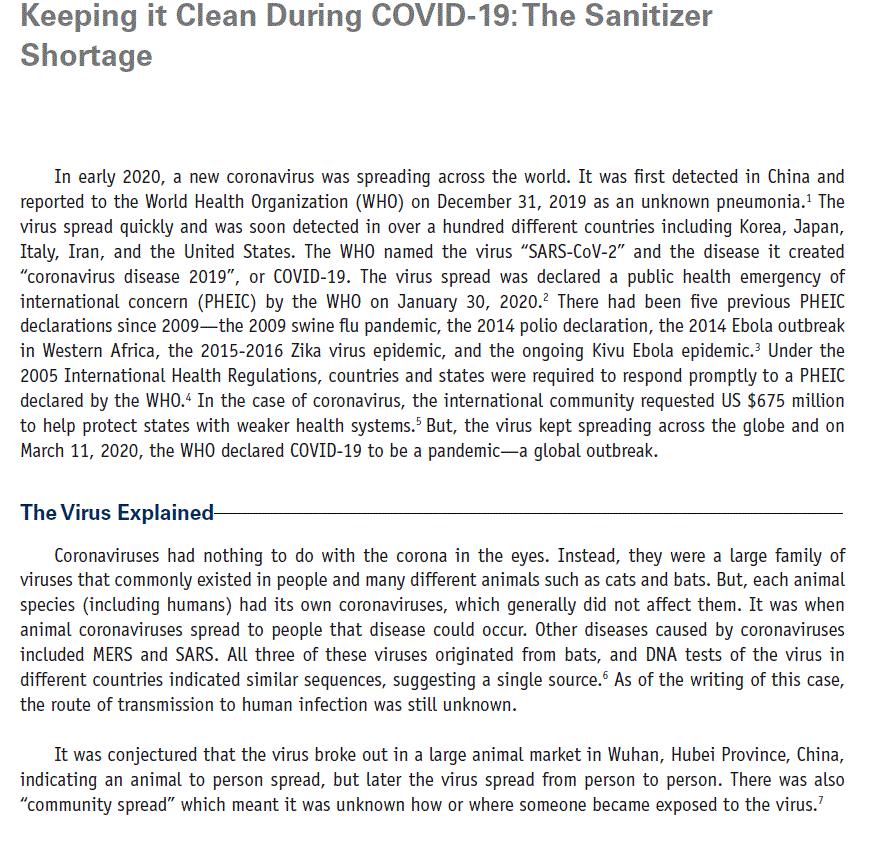Question
1. How the shortages in products related to the pandemic (example: sanitizer, masks, testing supplies) impact consumer behavior ? 2. What types of strategies a
1. How the shortages in products related to the pandemic (example: sanitizer, masks, testing supplies) impact consumer behavior ?
2. What types of strategies a company may use to control shortages and how these strategies may impact consumers and governments (e.g., pricing strategies, managing supply, imports, exports, etc.). Please explain in details.
3. Separate the strategies you mentioned into the two separate categories of supply and demand. Then state which strategy would be the best, in your opinion, to reduce the impact of a shortage, and why.


Keeping it Clean During COVID-19: The Sanitizer Shortage In early 2020, a new coronavirus was spreading across the world. It was first detected in China and reported to the World Health Organization (WHO) on December 31, 2019 as an unknown pneumonia. The virus spread quickly and was soon detected in over a hundred different countries including Korea, Japan, Italy, Iran, and the United States. The WHO named the virus "SARS-CoV-2" and the disease it created "coronavirus disease 2019", or COVID-19. The virus spread was declared a public health emergency of international concern (PHEIC) by the WHO on January 30, 2020. There had been five previous PHEIC declarations since 2009-the 2009 swine flu pandemic, the 2014 polio declaration, the 2014 Ebola outbreak in Western Africa, the 2015-2016 Zika virus epidemic, and the ongoing Kivu Ebola epidemic. Under the 2005 International Health Regulations, countries and states were required to respond promptly to a PHEIC declared by the WHO.4 In the case of coronavirus, the international community requested US $675 million to help protect states with weaker health systems.5 But, the virus kept spreading across the globe and on March 11, 2020, the WHO declared COVID-19 to be a pandemic-a global outbreak. The Virus Explained- Coronaviruses had nothing to do with the corona in the eyes. Instead, they were a large family of viruses that commonly existed in people and many different animals such as cats and bats. But, each animal species (including humans) had its own coronaviruses, which generally did not affect them. It was when animal coronaviruses spread to people that disease could occur. Other diseases caused by coronaviruses included MERS and SARS. All three of these viruses originated from bats, and DNA tests of the virus in different countries indicated similar sequences, suggesting a single source. As of the writing of this case, the route of transmission to human infection was still unknown. It was conjectured that the virus broke out in a large animal market in Wuhan, Hubei Province, China, indicating an animal to person spread, but later the virus spread from person to person. There was also "community spread" which meant it was unknown how or where someone became exposed to the virus.
Step by Step Solution
3.31 Rating (163 Votes )
There are 3 Steps involved in it
Step: 1
1 How the shortages in products related to the pandemic example sanitizer masks testing supplies impact consumer behavior The shortages in products related to the pandemic impact consumer behavior in ...
Get Instant Access to Expert-Tailored Solutions
See step-by-step solutions with expert insights and AI powered tools for academic success
Step: 2

Step: 3

Ace Your Homework with AI
Get the answers you need in no time with our AI-driven, step-by-step assistance
Get Started


